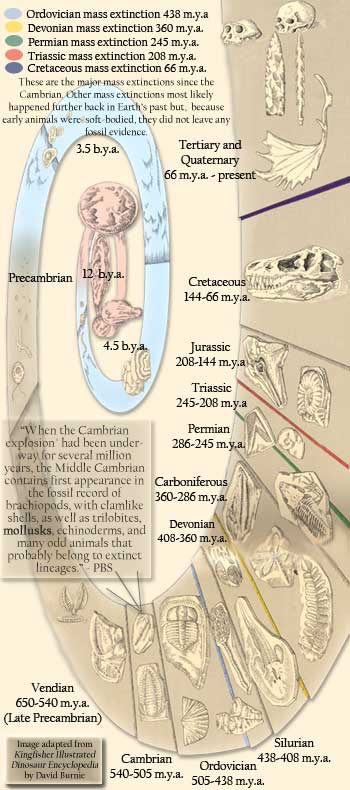
Edward T. Babinski: The first billion years of the earth's formation there was no life so far as anyone knows. The earth was being bombarded with debris as it cooled. And the early pre-Cambrian contains no fossilized evidence of even the simplest life forms. Some say that perhaps life or reproducing chemicals formed more than once and were destroyed more than once as asteroids from the early star system continued colliding with earth and the other planets, i.e., before the orbiting ring of matter round the sun had assumed more regular and less dangerous orbits.
From: When Did Mollusks First Appear?
-
What Is A Fossil?
A general introduction to the history of fossil discoveries, and the gradual progress of science and paleontology.-
How A Living Organism Becomes a Fossil
Taphonomy, the study of how living organisms become fossils, and five natural methods which explain how living organisms become fossils. -
Fossil History in Europe
Important milestones in European fossil hunting, including first professional fossil collector, Mary Anning. -
Major Geological Eons, Eras, Periods and Epochs, and How Fossils Are Used
Chart of major geological eons, eras, periods, epochs and events. How fossils are used by scientists to determine its relationship with other specimens, with objective to unravel evolutionary patterns and origins. -
Vendian Period and the Origins of Life
The Vendian World, a look at some of the first life forms that existed on Earth, and theories about the origins of life.
HISTORICAL ARTICLES
- Canadian Rockies: A Geologist's Paradise, National Geographic, June 1911
Charles D. Wolcott, secretary of the Smithsonian visits the Canadian Rockies. A look back to 1911, when science was first discovering the vast age of the earth, rich fossil record, and paleontology was still in its infancy.
REFERENCES
 Bringing Fossils to Life, An Introduction to Paleobiology, McGraw Hill Publishers, Donald R. Prothero
Bringing Fossils to Life, An Introduction to Paleobiology, McGraw Hill Publishers, Donald R. Prothero Paleobotany and the Evolution of Plants, by Cambridge University Press; 2 edition, Wilson N. Stewart, Gar W. Rothwell
Paleobotany and the Evolution of Plants, by Cambridge University Press; 2 edition, Wilson N. Stewart, Gar W. Rothwell Kingfisher Illustrated Dinosaur Encyclopedia, Kingfisher Publishers, David Burnie
Kingfisher Illustrated Dinosaur Encyclopedia, Kingfisher Publishers, David BurnieFURTHER SUGGESTED READING
Adrienne Mayor's books
1) The First Fossil Hunters (Princeton 2000) explains how ancient Greek and Roman discoveries of mysterious petrifed bones of extinct dinosaurs and mastodons led to myths about griffins, giants, and monsters. Watch for "Ancient Monster Hunters" on the History Channel.
2) Fossil Legends of the First Americans (Princeton 2005) gathers exciting Native American discoveries and myths about fossils, from tiny shells to enormous dinosaur bones, with stories from more than 45 different tribes, beginning with the Aztecs & Incas.Stephen Meyer's article, "Are Dinosaurs Mentioned in the Bible?"
Edward T. Babinski wrote: "In 1726 [Prof. J.J. Scheuchzer] mistook the skull and vertebral column of a large salamander from the Miocene of Oeningen for the "betrübten Beingerüst eines alten Sünders" (sad bony remains of an old human sinner) and figured the specimen as "Homo diluvii testis" (the man who witnessed the Deluge).
SOURCE: Dirk Albert Hooijer, "Fact and Fiction in Hippopotamology (Sampling the History of Scientific Error)," Osiris, Vol. 10. (1952), pp. 109-116.
Funny comment about the above sentence: Assertion, emphatic and immune to reason, might not be the best foundation for a new critical practice; but we also can’t tell our salamanders from sinners.
-


No comments:
Post a Comment